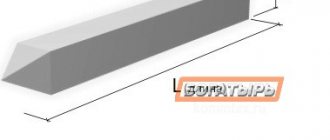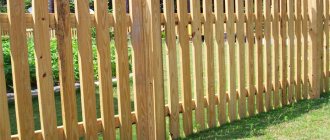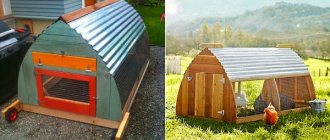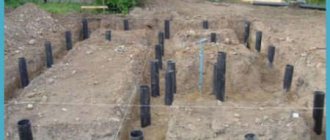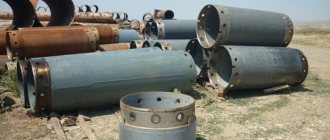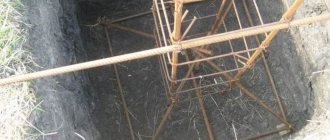What are screw piles
A pile is usually understood as a metal rod. It consists of a pipe with thick walls. At the bottom there is a helical blade and a sharp tip. This part is screwed into the ground. On the other side of the pipe there is a head. The lower parts of the building will be attached to it.
Design features
The widespread use of piles in construction is explained by some of the characteristics and capabilities of this product. Thanks to the sharp tip and the blades welded at the bottom, a spinning action is achieved. As a result, this action is transformed into a forward movement of the support.
With the help of such supports, foundations for houses are made. The main task is not to reduce construction costs, but to prevent soil heaving. It can occur under the weight of a construction project and at subzero temperatures.
There are several types of piles that differ in size.
- Narrow-bladed. Such products differ in appearance - they have a blunt end and are visually similar to a screw. They can be used in the construction of light buildings. Narrow-blade products have several modifications. The sharp tip is used for drilling hard rocks, the teeth along the perimeter are needed for construction in permafrost conditions.
- Broad-bladed. One large blade is welded to the sharp tip.
- Multi-lobed. A distinctive feature is the presence of several blades. This allows you to build larger houses (for example, with an attic).
Advantages of screw piles
Screw supports are in great demand when constructing foundations. This can be explained by the numerous advantages of such a scheme:
- No need for leveling the terrain. The construction of the foundation can begin without careful development of the site. This reduces the amount of land work by almost 90%.
- Speed. You can build a foundation for a house in 2-3 days. This reduces construction time.
- Budget savings. Compared to strip foundations, piles are 60-70% cheaper.
- Ability to work at sub-zero temperatures. Thanks to this feature, you can build a house even in winter.
- Simplicity and ease of installation. Anyone can tighten a pile with their own hands without hiring special equipment.
- Construction in swampy areas.
Soil research
When constructing a pile foundation, soil restrictions should be taken into account. Therefore, it is recommended to carry out diagnostic work on the site in order to determine the characteristics of the soil.
In addition to existing restrictions, the occurrence of obstacles when screwing piles cannot be ruled out. This may cause the pile to come out of line. Some risk is inevitable, but the situation is fixable. When a pile goes out of order, a head is used, which allows for partial alignment of the line.
If there is rocky soil or a large number of stones are identified at various levels, it is necessary to abandon the construction of a pile foundation. With a relatively small number of stones and their shallow location, construction work is allowed.
The type of soil is important
To determine the characteristics of the soil on the site, it is recommended to conduct geological surveys on your own. They consist of test drilling, which, in addition to clarifying the nature of the soil.
Starting work blindly can lead to unnecessary labor and time. In case of failure, the consumption of piles increases.
If in doubt, it is advisable to contact a specialized laboratory to clarify the data.
Installing screw piles with your own hands. Preparatory work
To install a strong, durable foundation, preliminary preparation should be carried out. It consists of several stages:
- Studying the soil at a construction site.
- Calculation of the weight of the finished house.
- Selection of optimal piles. Calculating their quantity taking into account the 2 previous points.
Soil analysis
The type of soil directly affects the technology for installing piles and building a foundation. Specialized companies carry out land research work. Based on the received report, one can judge the depth of soil freezing, its quantitative and qualitative composition, and the depth of the aquifer.
If the soil is stable, it is possible to screw in piles whose length is 2.5 m. If the construction site is located on difficult terrain, piles of different sizes will be required, taking into account the height difference.
Unstable topsoil requires installation of piles of such a length that would allow them to reach a layer of dense soil (clay, sand). In this case, the load-bearing element will be firmly fixed in the soil and will become a reliable support for the building. To clarify the depth of this layer, test drilling is often carried out. Based on the particles remaining on the blades, the type of layer can be determined.
To measure the length, attach a small weight to the rope and lower it into the hole until it reaches the bottom. A mark is made on the rope and after removing the load, the length is measured to the mark. It is necessary to use piles 0.5 m longer than is necessary according to calculations.
When building in seismic zones, the recess should reach 4.5 m.
Calculation of the mass of the house
It will not be possible to determine the exact mass of the house, because... The weight of all the furniture also matters here. However, the indicator can be as close as possible to the true one. To do this, take into account the weight of the following elements:
- all building materials that are used to build a house:
- furniture, household appliances;
- plumbing (bath, toilet, water basin);
- the mass of people who will be in the room;
- layer of snow that will lie on the roof in winter (approximate data can be taken from a specialized map by region).
Calculations. Length, diameter, number of piles
To calculate the number of pipes needed, you need to take into account several characteristics:
- development project;
- house dimensions;
- material for construction.
| Material of which the building is made | The distance that must be maintained between supports |
| Wood, frame technology | 2.5-3 m |
| Gas blocks, foam blocks, some other materials that allow the use of a pile foundation | 1.5-2 m |
If strong winds are observed in the construction region, the supports should be positioned with a smaller pitch (not 3 m, but 2.5 m).
The formula used for the calculation is as follows: the sum of all possible loads should be divided by the bearing load of 1 pile.
Rules for placing piles. Marking on the ground
First of all, the location is applied to paper. This is done according to the design documents:
- The area of the base of the house is divided into rectangles.
- Supports must be present at each corner and in the middle of load-bearing walls.
- The remaining distance between the supports is divided into equal intervals. It is important to take into account the permissible step taking into account the construction features.
- If there is a fireplace or column in the house, a support is also installed in this place.
After creating the pile foundation project, you should proceed to marking the ground. Wooden beams are placed in the places where the supports will be placed (it is better to sharpen the lower ends). Ropes should be stretched between these stakes along the perimeter and diagonals of the future foundation. The location of the supports must strictly correspond to the design.
Pile-screw foundation: advantages and disadvantages
Constructing the foundation of a house using piles is an interesting, and in some cases, the only technical solution. The design of such a foundation has a number of advantages:
- Strength characteristics are at the level of structures made of brick or reinforced concrete.
- The cost of constructing such a foundation is lower compared to other foundation options, since the installation of piles does not require labor-intensive excavation work using special equipment. The construction of a pile foundation does not involve the need to remove waste at the construction site. The high speed of foundation construction and minimal labor requirements also lead to a reduction in the estimated cost of work.
- When carrying out construction on weak or heaving soil, this foundation design is irreplaceable.
- Possibility of building houses in difficult conditions.
- Work can be carried out all year round. They can continue without stopping after the construction of the foundation, since the piles are not subject to shrinkage.
- The bearing capacity of the structure is at a high level, and during the process of screwing in the piles, the soil is compacted. The design of the blades allows for even distribution of loads and prevents heaving of the soil when it freezes.
- If the installation technology is followed, the foundation can last about a hundred years.
It should be noted that screw piles have one drawback - the material from which the piles are made. Due to the fact that they are made of metal, there is a high risk of corrosion processes. Therefore, you should pay close attention to the quality of the piles.
Another disadvantage of a pile foundation: if there are layers of hard limestone, in stony or rocky soil, construction work is impossible. It is also impossible to build a basement in a house with such a foundation. If we provide for the presence of a basement, then the costs will be equal to the cost of constructing a strip foundation.
Kinds
Do-it-yourself pile installation
Installation of piles in a small area can be carried out without the use of special equipment. A team of several people will be able to cope with this task within a few days. The tools you will need are a screw structure consisting of a pipe (its diameter must exceed the diameter of the support itself).
The pipe should be modified: make several holes for a reliable connection with the support and 2 eyes (levers will be installed in them). If it is necessary to install long pipes (up to 400 cm), the presence of several people will be required. One of them should periodically check the level of the support. The easiest way is to make a pile roll with your own hands according to the drawings.
Tools. Installation equipment
To install the supports manually, you will need the following tools:
- levers (thick-walled pipes, 250 cm long and 5 cm in diameter);
- sledgehammer, hammer, jig, shovel, crowbar;
- building level and tape measure;
- reinforcing bars (can be replaced with wooden stakes);
- marker or chalk for marking;
- Bulgarian.
Manual labor can be replaced by the use of equipment for driving piles:
- Hydraulic rotator. This device is necessary for installing supports with a diameter of 80 mm or more.
- A design that allows you to tighten the piles with a drill and a gearbox with a wrench (some resort to tightening the piles with a meat grinder).
Installation technology
First of all, install the corner supports. To do this, make a small pit (the depth should be 50-70 cm). A support is installed in this hole and they begin to screw it. A device for screwing piles can make the task easier. To make it, a crowbar is inserted into the technical hole of the support. After this, pipes of suitable diameter are put on both sides.
How to tighten screw piles using a motor drill. Types of motor drills used
When installing piles with your own hands (in the case of a large pipe diameter), it is faster and easier to carry out the work using a motor drill. There are several varieties of these instruments. The difference lies in the type of motor and power of the device:
- Mechanized, with engine power up to 3.5 l/s. Their weight reaches 11 kg, so 1 person can work with it. The disadvantage is that it is recommended to use such devices only for drilling soil of categories 1 and 2.
- Mechanical, in which the engine has a power of 3.5-7 l/s. Their weight is about 30 kg, so the presence of several people is required. Such motor drills are also used for soil categories 1 and 2.
- Two-block. This pile drill consists of a drilling part and a motor. They are more powerful, so they are suitable for category 3 soil. In addition, thanks to its convenient design, you can operate such a drill alone.
Machine for driving screw piles Iron-219
To install supports for foundations, specialized installations for driving piles are often used, including Iron 219. The main task of this device is to drive piles.
If the work is carried out by the operator and workers, the device can install supports with a diameter of up to 133 mm. Piles with larger diameters will require securing to a vehicle.
Pile driving technology
Choosing tools
An important step when manually tightening screw piles is the choice of tool. This will simplify the work and reduce time. You will need:
- a shovel will be required to level the surface of the earth at the point where the pile is installed;
- plumb line to control the verticality of piles;
- building level, for setting marks in the horizontal plane;
- tape measure for taking measurements;
- hammer or small sledgehammer;
- two pipes and a crowbar, for use as levers;
- rope or twine for marking;
- an angle grinder equipped with discs for cutting piles;
- other tools available on the farm.
Pile field marking
The preliminary stage before marking the pile foundation is to calculate the number of supports.
Technically competent placement of piles will ensure the reliability and durability of the building as a whole. When carrying out calculations, the following general principles are adhered to:
- when constructing lightweight structures, the interval between piles should not be increased by more than 3-3.5 m;
- for heavier structures, the supports are located at a distance of less than 3 m, and in the presence of wind load - up to 2.5 m;
- during the construction of frame structures or log buildings, it is possible to install piles at intervals of 3 m;
- in the case of block construction, the distance between supports should not exceed 2 m.
The implementation of calculations on the construction site, that is, marking, must be carried out with special care. To do this, it is necessary to determine a basis that will serve as an accurate reference.
Carrying out field marking work
Any side of the foundation is selected and a perfectly straight line is drawn (parallel to the road or fence).
Next, at a distance that depends on the design features of the structure, the twine is pulled between the driven rods (pegs). In this case, the marking line is slightly longer than the size of the foundation. As a result, when the lines intersect, the dimensions will be larger than required. This feature will avoid interference caused by the rods and will make it easier to control the correct screwing of the piles.
Methods for installing piles
Screwing screw piles can be done manually or mechanized. The use of mechanization is necessary if the diameter of the piles exceeds 108 mm. An increase in mass makes manual labor unproductive and the risk of deviation from the vertical increases significantly.
When carrying out construction work in difficult soil, it is impossible to do without special equipment and the use of guides. It is almost impossible to mount piles within the permissible deviation from the vertical position (it is 2°).
Technique used
The construction of large objects is carried out only by special equipment, the operation of which is subordinated to an on-board computer.
The increase in pile dimensions is only one of the reasons for the need to mechanize the screwing process. Another is that obstacles may arise when passing through the ground.
During the course of work, it is possible to identify defects in piles, which leads to a deterioration in the reliability of the foundation. Most often, manufacturing defects are observed at the junction of the blade and the pipe, that is, due to the poor quality of the weld.
Screwing screw piles by hand
Holes are dug in accordance with the markings of the pile field. A shovel or drill is used for this. The holes act as guides, so there is no need to go deeper than 400 mm.
As reference points for the entire structure, the corner piles are installed first. They are inserted into the holes and sprinkled with soil, which is compacted at the end of the work.
This stage is critical and requires giving the piles a strictly vertical position. Before starting the process of screwing the piles, prepared levers are inserted into special holes in it. Two people are enough to do this job. Having the skills will reduce the time for twisting to 15-20 minutes.
Manual work
The screwing process continues until the blades reach a depth exceeding the freezing level. Throughout its entire length, constant monitoring is carried out over the perpendicularity of the position of the pile.
If an obstacle arises in the path of support, the efforts should be increased. If the depth has reached a depth of one meter, it is allowed not to take any action and leave everything as is. At shallower depths, the screw-in point should be moved. In critical cases, the entire foundation is transferred.
When the required depth is reached, the pipe is cut using a grinder at the required distance. Concrete grade M300 is used to fill the shaft. This process occurs until the entire length of the pipe is filled.
When constructing a foundation for a temporary structure, pouring is not performed. Next comes tying the head to the barrel and anti-corrosion treatment of the surface and seams.
Making screw piles with your own hands
Professionals do not recommend making piles yourself, because... errors in work lead to misalignment of the foundation and building. If a decision is made in favor of self-production, it must be done correctly.
All piles consist of several parts:
- thick-walled pipe (base);
- blades;
- sharp tip.
First of all, you need to cut out the blanks. The most convenient and fastest way to do this is using a template.
- Blades. The blade blank consists of two circles (large and small) with a common center. The diameter of the inner circle is equal to the diameter of the pipe. The diameter of the outer circle will be equal to the size of the blade.
- Tip. To create the tip you will need 4 triangles. Their height is equal to double the diameter of the pipe. The parameters of the base of the triangles are calculated according to the following scheme: the outer diameter of the trunk should be multiplied by 3.14. The figure obtained as a result of multiplication must be divided by the number of sectors (in this case - 4).
The blanks are cut out and welded to the pipe. In this case, several rules must be followed:
- from the cone to the bottom edge of the spiral should be at least 50 cm;
- During welding, the seam should not be intermittent.
The main mistakes when installing a pile foundation yourself. Possible difficulties
At first glance, driving piles yourself looks like a simple task, but unskilled workers often make the following mistakes:
- Lack of preliminary soil study. In such cases, there is a high risk of installing the foundation at insufficient depth. This directly affects its stability.
- Deviation from vertical. Over time, this leads to skewing of the foundation.
- Digging deep holes before installing supports. In this case, the soil compaction process is disrupted, which affects the strength of the foundation.
- Incorrect cutting of piles.
Construction of the foundation
Building a foundation on screw piles is both simple and complex. Simple, because their design allows you to significantly simplify and speed up work. Complex because it requires precise calculations and a certain sequence of work.
Geology
The construction of the foundation should begin with engineering and geological surveys. To carry them out, geologists who have the right to do so are hired. If we are talking about a cottage or dacha village, then surveys are often carried out at the stage of dividing the plots.
Their task is to determine the type of soil and its physical characteristics.
Calculation
Perhaps the most difficult stage in the construction of a pile foundation is the accurate calculation. Despite the fact that all the details are given in SP 24.13330.2011 “Pile foundations”, they still require some experience.
Today you can find a calculator that will automatically calculate both the standard size of piles and their number. The parameters on which the standard size depends include the size of the building, its type, soil type, including its moisture and density. A good calculator takes them all into account.
Step
One of the most important characteristics determined when calculating the foundation is the pitch. Of course, it can be calculated based on what the calculator shows, but there are certain properties that are always the same.
So, the step should not exceed two to three meters, otherwise it can be dangerous for the house. In general, it should be 20–30% smaller than the size of the load-bearing walls. From the video clip you will learn how to correctly calculate the required number of piles.
Structure weight
Each part of the house structure has its own weight, which affects foundation calculations. It depends on the materials used in construction, as well as the size, whether the house is one- or two-story, etc.
Typically, external walls and ceilings carry the greatest weight. So, in a wooden house on two floors, measuring 6 by 8 meters, the first will weigh approximately 16 tons, and the second - 10 tons. The total weight of all structures can reach 71 tons. When calculating the load, this number is increased by thirty percent. A special calculator will allow you to calculate everything in more detail.
Snow and wind load
For the domestic climate, it is very important to take into account in the calculations the load that snow and wind have on the house. If in some regions the second is especially important, then for most it is the snow load that is paramount. For Central Russia it is at least 100 kilograms per square meter.
Number of piles
The quantity is calculated based on their standard size, soil characteristics, and the load exerted by the house. All this can be calculated by a calculator. You can do the calculation manually, strictly following the instructions of SNiPs.
Length
The main characteristics that influence the length are the physical properties of the soil and the depth to which it freezes. The weaker the soil and the higher the freezing depth, the longer the products.
Screw piles and concreting of caps
To prevent corrosion, concreting should be carried out. The optimal material for this purpose is a solution of sand and cement grade M150.
The final stage is the installation of the heads. This is done in several stages.
- Heads are placed on top of the piles.
- The parts are welded using a welding machine.
- The seams resulting from the work are thoroughly cleaned. They are treated with an anti-corrosion agent.
Compliance with all of the above requirements will allow you to correctly install a reliable, durable foundation for any low-rise building.
